A seeming late winter’s grey grip on midtown loosened at the Tibor de Nagy Gallery as the lift doors opened on a cornflower blue wall with a single, strong painting at its center, Shirley Jaffe’s Adria’s Green (2014). The main gallery offered more vernal greens and blues, golds and lemon and orange and blooms of scarlet, rose and crimson. Could real spring weather be far behind?
.

"Adria's Green" by Shirley Jaffe, 2014. Oil on canvas, 28 ¾ x 23 ½ inches.
.
In league with the bold wall tone, Adria’s Green is a terrific choice as a gateway into “Shirley Jaffe: Paintings and Works on Paper,” on view at the gallery through May 2, 2015. The top right corner has a secure polygonal zone of an engaging green cut with blue and white, under and around which a jaunty geometry of red rectangles and yellow forms dance their gigue while a black line takes its tour gracieux across and among them. Even before the viewer zooms in on how crisply the edges lock together and the gratifying swing of brush strokes inside the white zones, there are smiles to be reaped from the joyous life on canvas.
Born in New Jersey and raised in Brighton Beach, Jaffe is identified with an American and Canadian expatriate community of painters living in Paris during the 1950s and ’60s (she sublet her Rive Gauche studio space from Louise Bourgeois and consorted with Joan Mitchell, Ellsworth Kelly, Sam Francis, and Jules Olitski, who was on the same same boat over in 1949). Her paintings are in the Centre Pompidou as well as MoMA, and a handsome monograph has just been published by Flammarion.
Distinguished writers on Jaffe’s work, including John Ashbery and Linda Nochlin, have explored the painterly traces of cultural and identity issues (the American woman painter in Paris). A dedicated art historian, meanwhile, could have a field day with influences. Checking these against the authorized monograph by Raphael Rubinstein, it turns out there is a personal validation for echoes of Kandinsky, Al Held, Ellsworth Kelly, Sam Francis (the vigorous X), and Matisse (more for his “optimism,” she insists, than the shapely blue undulations and Jazz-y zigzags (pair Matisse’s Le Cowboy with Jaffe’s Night Time).
.
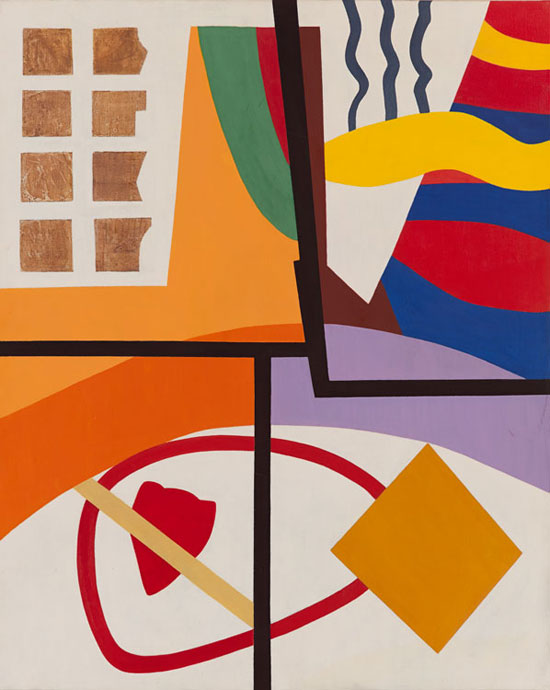
"Night Time" by Shirley Jaffe 2005. Oil on canvas, 31 ½ x 25 ¼ inches.
.
I found Matisse leaf forms discreetly concealed under a scrim of white in the lower right corner of Untitled (#12), one of the mixed media on paper works from 1998. I also thought of Hans Hofmann as I admired the mobility of Jaffe’s red and gold rectangles and the calligraphic confidence of gridded black lines in the work on paper Untitled #35, and even of Gerhard Richter’s scraping across color on the right side of Untitled #13.
.
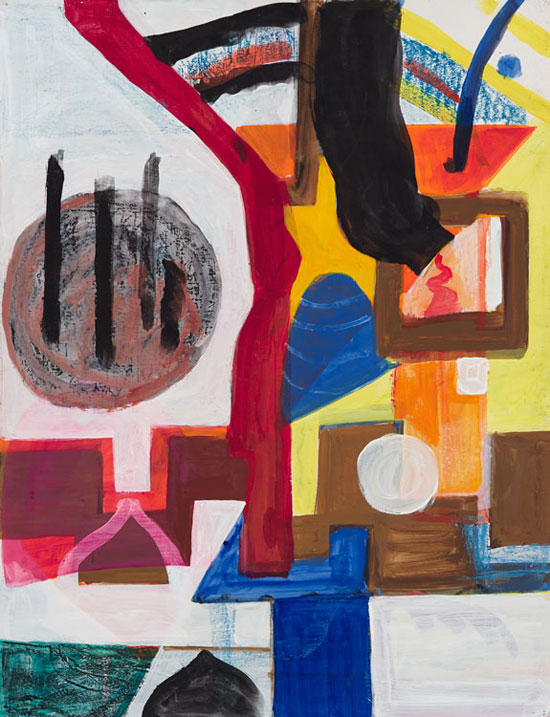
"Untitled (#12)" by Shirley Jaffe, n. d. Mixed media on paper, 25 5/8 x 19 ¾ inches.
.

"Untitled (#35)" by Shirley Jaffe, n. d. Mixed media on paper, 19 ¾ x 15 ¾ inches.
.

"Untitled (#13)" by Shirley Jaffe, n. d. Mixed media on paper, 25 5/8 x 19 ¾ inches.
.
I also picked out versions of Alexander Calder’s play of red and yellow and Fernand Leger’s swaths of flat color that cut across figures (inspired by a visit to Times Square where he was astonished to see his companions bathed in blue light, then red, then yellow under the neon lights).
One antecedent that Jaffe is on the record as rejecting rather too emphatically is Stuart Davis (she says she was not in New York when his work was mostly on view). Isn’t it droll when artists demur in this way?
Index cards reproduced in the book document the decision-making process as colors are swapped and forms are circulated during the progress of the paintings from one stage to another. In a crucial letter addressed to her dealer and champion Jean Fournier on January 28, 1982, wisely cited in full in the book, she corrects his impression that her modus operandi was a matter of “redoing or rethinking” by firmly pointing out that it is a process of “constructing.”
She wrote: “I must, to avoid the unfortunate surprises that I had in the past, begin to work lightly and more and more build up the colors and the forms … the color becomes pure when I speak of ‘every color has white within it.’ That’s to say the color is not finished. There is a sonority that I want to get to, and sometimes though it is imperceptible to others it rings false to me.”
The truth of her colors is evident in such a tightly constructed major work as Horizontal Black (2015), bifurcated, as many of her horizontal paintings are, between an architecturally solid left side and the curvy, floating right hand side. The contrapuntal play of two moods is as musical as it is art historical, and a notable passion of Jaffe’s is the chamber music of Elliott Carter who had a similar genius for sound construction and spiky fragmentation.
.

"Horizontal Black" by Shirley Jaffe, 2015. Oil on canvas, 45 x 57 ½ inches.
.
Jaffe is a painter’s painter. Tara Dixon, a marvelous talent with the brush who studied a few steps away at the Art Students League, happened to be in the gallery the day this reviewer visited, absorbed in the works on paper. Nodding at the technical accomplishment, she admired the “freedom” and “playfulness” of the work. “Lyricism is reduced to brush strokes and the application of paint within the color blocking,” Dixon adroitly observed, and between the paintings and the works on paper I admire the restraint versus abandon.”
It is not so spring-like around the corner at Marian Goodman Gallery, where the Arte Povera eminence grise Giuseppe Penone offers a wintry grove of white marble tree trunks and branches choreographed like figures in the urban plazas of Giacometti.
.
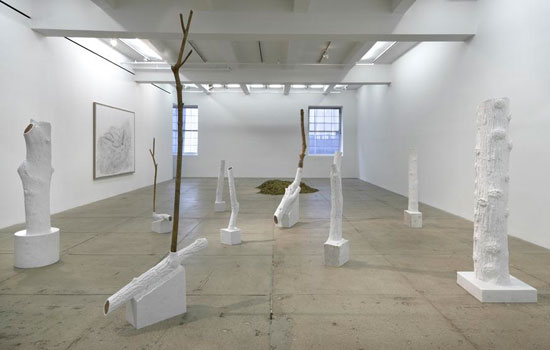
Installation view of "Giuseppe Penone" at Marian Goodman Gallery.
.
About halfway up each of these, a similarly tight cast of the branch in bronze continues the form, and the combination of the two luxuriant and historically powerful materials, conveying the knobby ridges of real bark, should delight lovers of nature and sculpture.
.

“Indistinti Confini - Aternus (Indistinct Boundaries - Aternus” by Giuseppe Penone. Marble, Bronze, 54 5/16 x 15 5/16 inches.
.
The powdery, luminous white of the marble and the iridescence of the bronze beg to be touched. For curator Dieter Schwarz, who has worked with Penone for three decades (jet-set Germano Celant, another curator, is also one of his champions) the haptic outweighs the optic. He notes that “the bark is also an image of the history of the people who have lived with the forest.”
.
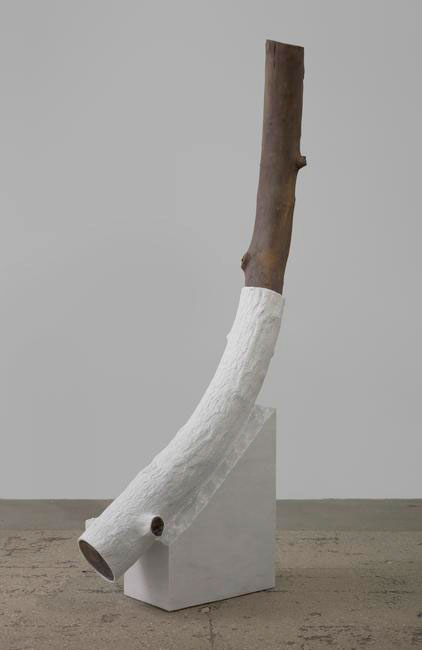
“Indistinti Confini - Rubico (Indistinct Boundaries - Rubico)” by Giuseppe Penone, 2012. Marble, Bronze, 83 7/16 x 41 5/16 x 11 3/4 inches.
.
Familiar to New Yorkers since the 1980s, Penone is a perennial presence at Documenta and the Venice Biennale, museums across Europe including the Kunstmuseum Winterthur, the Whitechapel Gallery in London and the Francois Pinault Foundation and the Fondation Cartier in Paris.
The viewer craves lyricism as well as wisdom from this installation. The artist offers a prose poem for the catalogue:
“Pure, white, luminous calcium enclosed in the mountains, in the seabeds, in our body. White as milk, clouds, snow, ice crystals that cloak the colors of the earth. A tree trunk of marble, of calcium, encloses, in our thought, the carbon, the plant, and the plant the mimicry of the color of the bronze and the color of the bronze, the green of the foliage and the trees, the flow of matter, of water, of rivers where there courses the subterranean life of the world, of veins whose flow is enclosed in our body, as in the mountain’s cavity of marble.”
The keys to the thematic power of the show are the delicate drawings in the next gallery and, if I may recommend a first stop, a painting in the third gallery of a huge tree trunk rendered meticulously in cross section. Viewers who kneel and zoom in will see a fingerprint at the center, and, brilliantly as well as movingly, I think, the whorls of the human fingerprint continue the striations of the trunk, harmonizing human and natural.
Wordsworth once wondered about the future of this affinity: “Little we see in nature that is ours.” Penone would ask us to reconsider that parting of the ways.
.
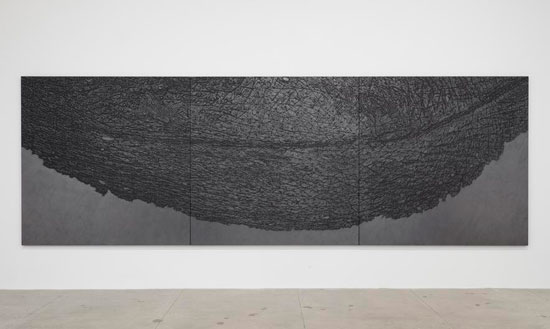
“Pelle Di Grafite - Palpebra (Skin of Graphite - Eyelid)” by Giuseppe Penone, 2012. Graphite on black canvas, 78 3/4 x 236 1/4 inches overall.
.
BASIC FACTS: “Shirley Jaffe: Paintings and Works on Paper” remains on view through May 2, 2015 at Tibor de Nagy Gallery, 724 Fifth Ave, New York, NY 10019. www.tibordenagy.com
“Giuseppe Penone” remains on view through April 25, 2015, at Marian Goodman Gallery, 24 West 57th Street, New York 10019. www.mariangoodman.com,
_____________________________
Copyright 2015 Hamptons Art Hub LLC. All rights reserved.
